If you like history, Rhode Island should be on your must-visit list, as it was the first of the thirteen colonies to declare independence from Great Britain in 1776. In addition to its history, the state boasts lots of beaches and casinos where you can spend your time, as well as several forests and parks where plenty of animals, including birds, live.
Of the 431 bird species that currently reside in Little Rhody, 10 are woodpeckers, and you’re in luck; we’re going to tell you everything you need to know about these wonderful birds.
Lewis’s Woodpecker

- Scientific Name: Melanerpes lewis
- Length: 10-11 inches
- Weight: 3.1-4.9 ounces
- Wingspan: 19.3-20.5 inches
Its pink belly, gray collar, and dark green back make Lewis’s woodpecker stand out from other woodpecker species.
This bird’s habits also separate it from the rest; instead of using its bill to dig for wood-boring bugs or larvae, it plucks insects from the outer surfaces of trees or more commonly swoops through the air to catch them in flight.
Find this medium-sized woodpecker in pine forests, woodlands near water (like streams), or burned forests with dead trees.
Red-Headed Woodpecker
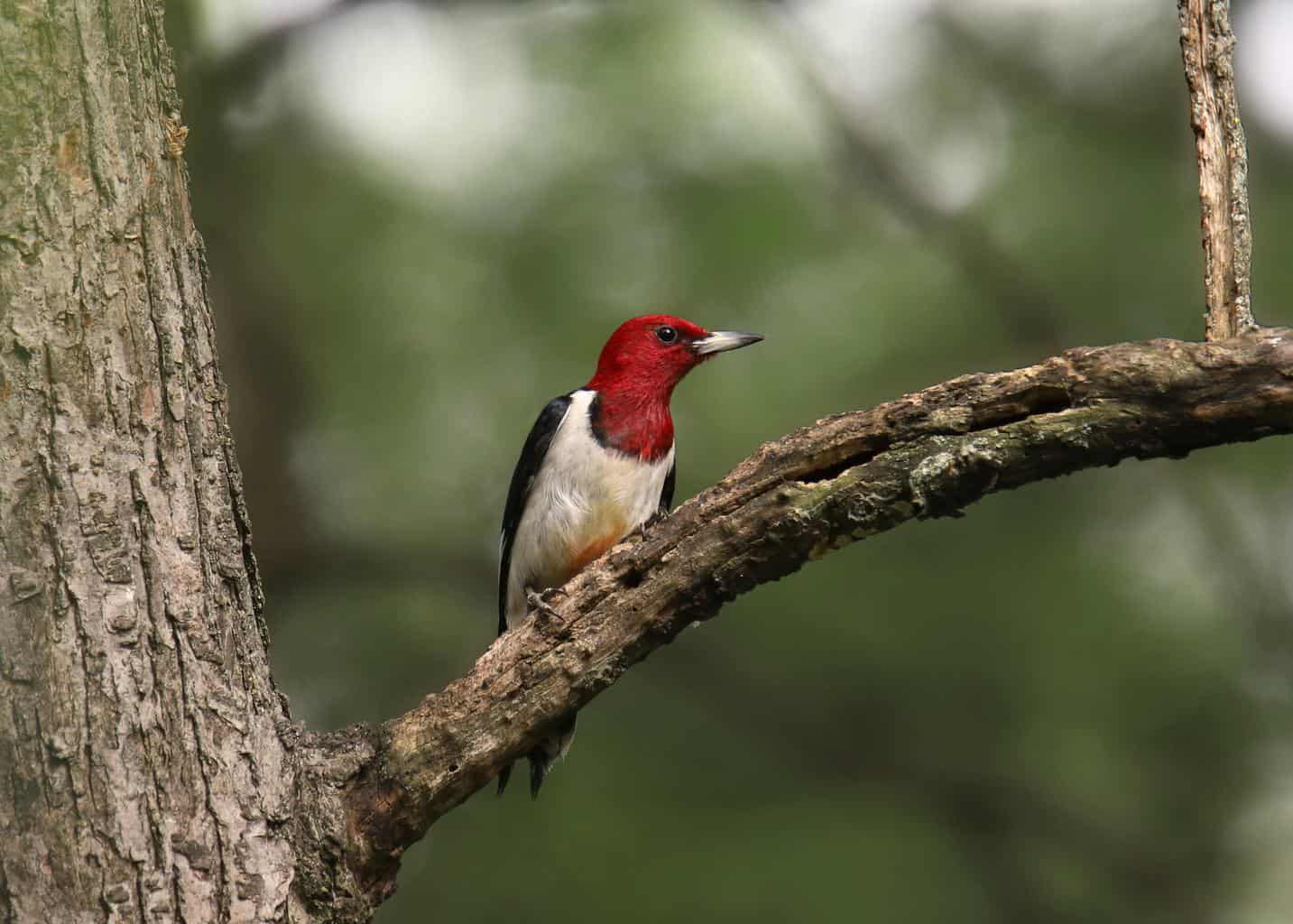
- Scientific Name: Melanerpes erythrocephalus
- Length: 7.5-9.8 inches
- Weight: 2-3.4 ounces
- Wingspan: about 16.7 inches
Thanks to its bold black and white patterned wings, the red-headed woodpecker is known as a flying checkerboard. And of course, the feature for which the creature is named — a bright red head — is an easy means of identification, as well.
The crimson-crowned beauty uses its spike-like bill to forage for wood-boring larvae in open forest areas. When food is scarce, it will feed on nuts, seeds, grains, grapes, cherries, younger birds, and small rodents.
Of the United States’ woodpeckers, the red-headed species is the most widespread, popping up in almost every state across the nation.
And if you hang a feeder filled with suet or nuts, one or two members of this species just may drop by your backyard to say a quick hello to you and your family.
Red-Bellied Woodpecker

- Scientific Name: Melanerpes carolinus
- Length: 9-10.5 inches
- Weight: 2-3.2 ounces
- Wingspan: 15-18 inches
The Melanerpes family continues its presence in Rhode Island with Melanerpes carolinus. You may know it by its common name: the red-bellied woodpecker.
Though it is strikingly similar to its red-headed cousin, the red-bellied woodpecker is more easily found. Its name, however, is a bit misleading; its stomach feathers are not the bright red hue you would expect but are a pinkish color instead.
These woodpeckers, medium in size, sport a red cap and barred back, and spend their time foraging for larvae in the crevices of dead trees using their barbed-tip tongues and sticky spit. They like to feed on spiders, wood-boring insects, acorns, nuts, seeds, grains, pine cones, lizards, and smaller birds.
Similar to the acorn woodpecker, this species likes to hide nuts in crevices of trees and might even hide bugs to be eaten later. And if you a feeder with suet, this woodpecker will soon embark on a flight right to your backyard.
Yellow-Bellied Sapsucker
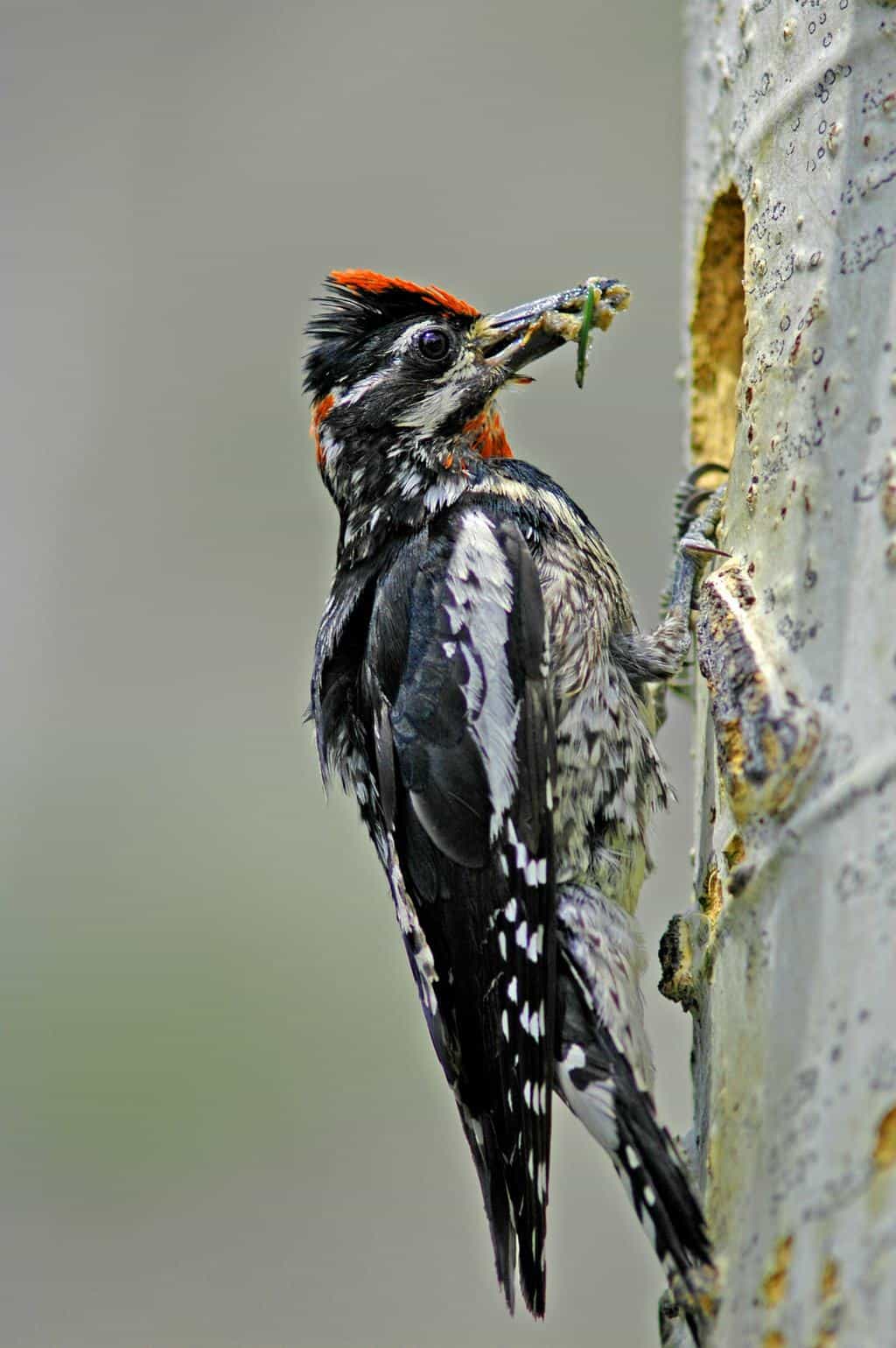
- Scientific Name: Sphyrapicus varius
- Length: 7.5-8.3 inches
- Weight: 1.2-2.2 ounces
- Wingspan: 13.4-15.8 inches
When yellow-bellied sapsuckers conclude their breeding season up north in Canada, they make their way to the great state of Rhode Island for the winter. Once they’ve arrived in the Ocean State, find these woodpeckers around maple and birch trees where they can dig sap wells.
It’s common for the sapsucker’s well-organized wells to attract other wildlife that feeds on sap and the larvae that end up stuck in it. And when this woodpecker isn’t using its long bill to drill in trees, it’s clanging noisily about, drumming on both wood and manmade metal objects for communication with other members of its family and to mark its territory.
Both males and females of this species are known to have red foreheads, which appear brighter in males, but the primary difference between the two is that the feathers on the male’s throat are red while those on the female are white.
American Three-Toed Woodpecker

- Scientific Name: Picoides dorsalis
- Length: 8.3-9.1 inches
- Weight: 1.6-2.4 ounces
- Wingspan: 14.6-15.3 inches
At first glance, the small size of this species creates the illusion of weakness. But actually, these woodpeckers are strong — maybe even strong enough to hit a tree harder than any other woodpecker. It has a strong blow and leaves patchwork revealing the lighter inner layer of tree bark versus the darker outer layer.
This woodpecker flakes or scales the bark from tree trunks and doesn’t dig deep to forage for larvae like other woodpeckers. It usually calls and drums on trees, especially during spring and summer.
Find these woodpeckers in northern North America, and expect their population to become more widespread when wood gets infested with bark beetles, burned, or is otherwise disturbed.
Males wear a messy black and white barred back, white spots on each wing, and yellow feathers on their foreheads. Female American three-toed woodpeckers have this yellow patch, too, but only as juveniles.
Black-Backed Woodpecker
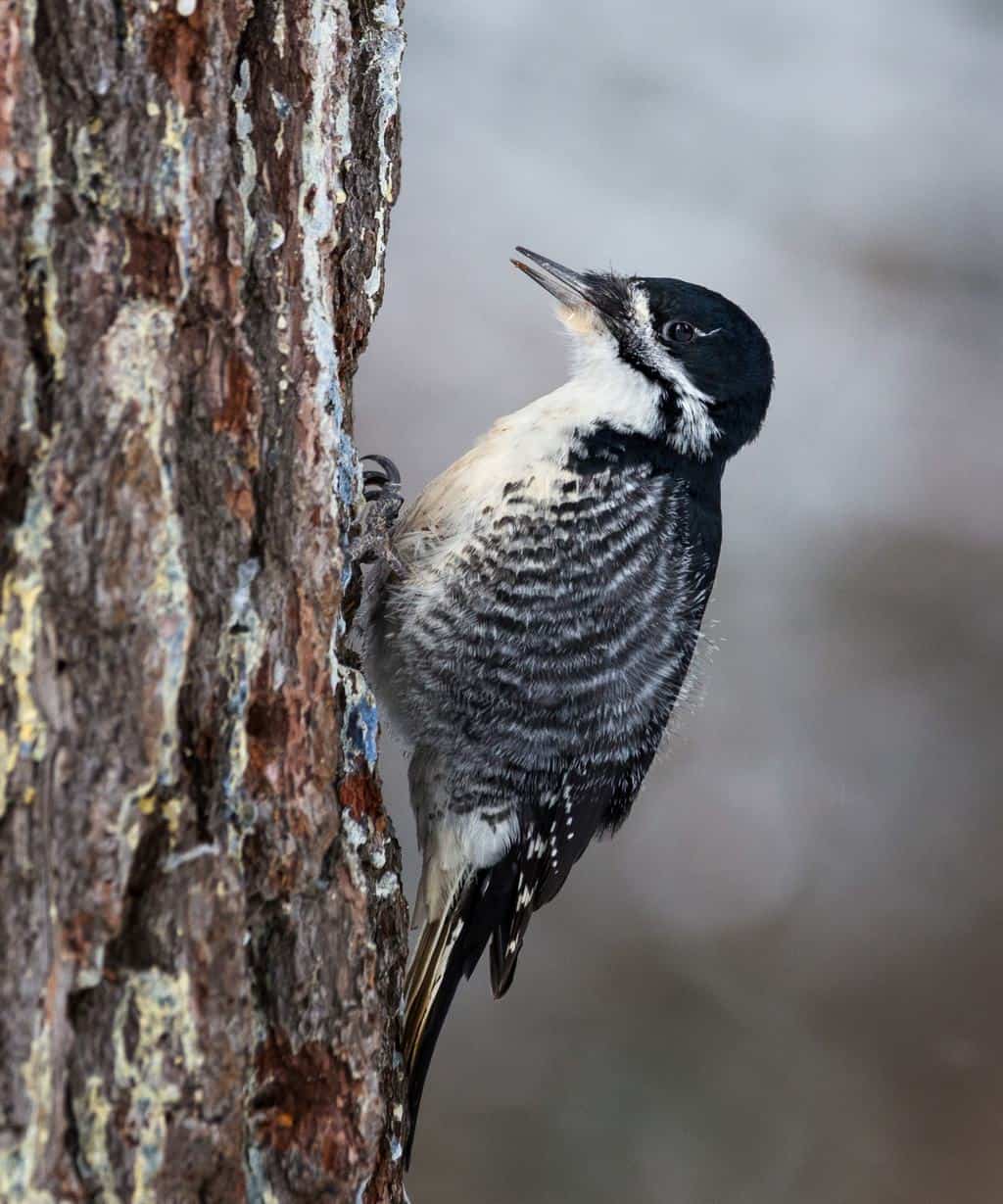
- Scientific Name: Picoides arcticus
- Length: about 9.1 inches
- Weight: 2.1-3.1 ounces
- Wingspan: 15.8-16.5 inches
Also known as the Arctic three-toed woodpecker, this bird has a jet-black back and a belly coated in white feathers. For sex identification, it’s important to note that the crown of adult males and juveniles of both sexes are kissed with a touch of yellow while those of adult females are not. Because it loves feeding on wood-boring beetles that infest recently burned trees, the white feathers are usually gray and covered in soot.
Just like the feathered friend mentioned above, woodpeckers of this species are a part of the three-toed family. The missing toe lets the bird lean further back to deliver a stronger blow, allowing it to excavate healthier and stronger trees.
This bird has a sharp call and, thanks to its inky color, blends easily with the charred tree trunks where it likes to feed on wood-boring beetle larvae.
Pileated Woodpecker

- Scientific Name: Dryocopus pileatus
- Length: 16-19 inches
- Weight: 9-14 ounces
- Wingspan: 26-30 inches
Did you know this big bird, dressed in a black and white striped back and red crest, is the inspiration behind the famous Woody Woodpecker cartoon? Well, it is! Besides looking for something that looks just like a television character, identification of the pileated woodpecker is fairly simple: not only does it have a bright red crest and white stripes on the sides of its face, it’s also a large bird — almost as large as a crow!
You may hear these woodpeckers before you see them, though; they’re loud, letting out whinnying calls, and are known to drum on a tree in a slow, rolling pattern.
Our pileated pal has a strong bill that allows it to dig deep and broad rectangular holes in trees to look for carpenter ants. It also feeds on grasshoppers, beetle larvae, caterpillars, and spruce budworms. When food is scarce in winter, it might visit your backyard if you fill a bird feeder with suet or sunflower seeds.
A fun fact: the pileated woodpecker is the only member of the Dryocopus genus in the United States, and therefore, in Rhode Island.
Downy Woodpecker
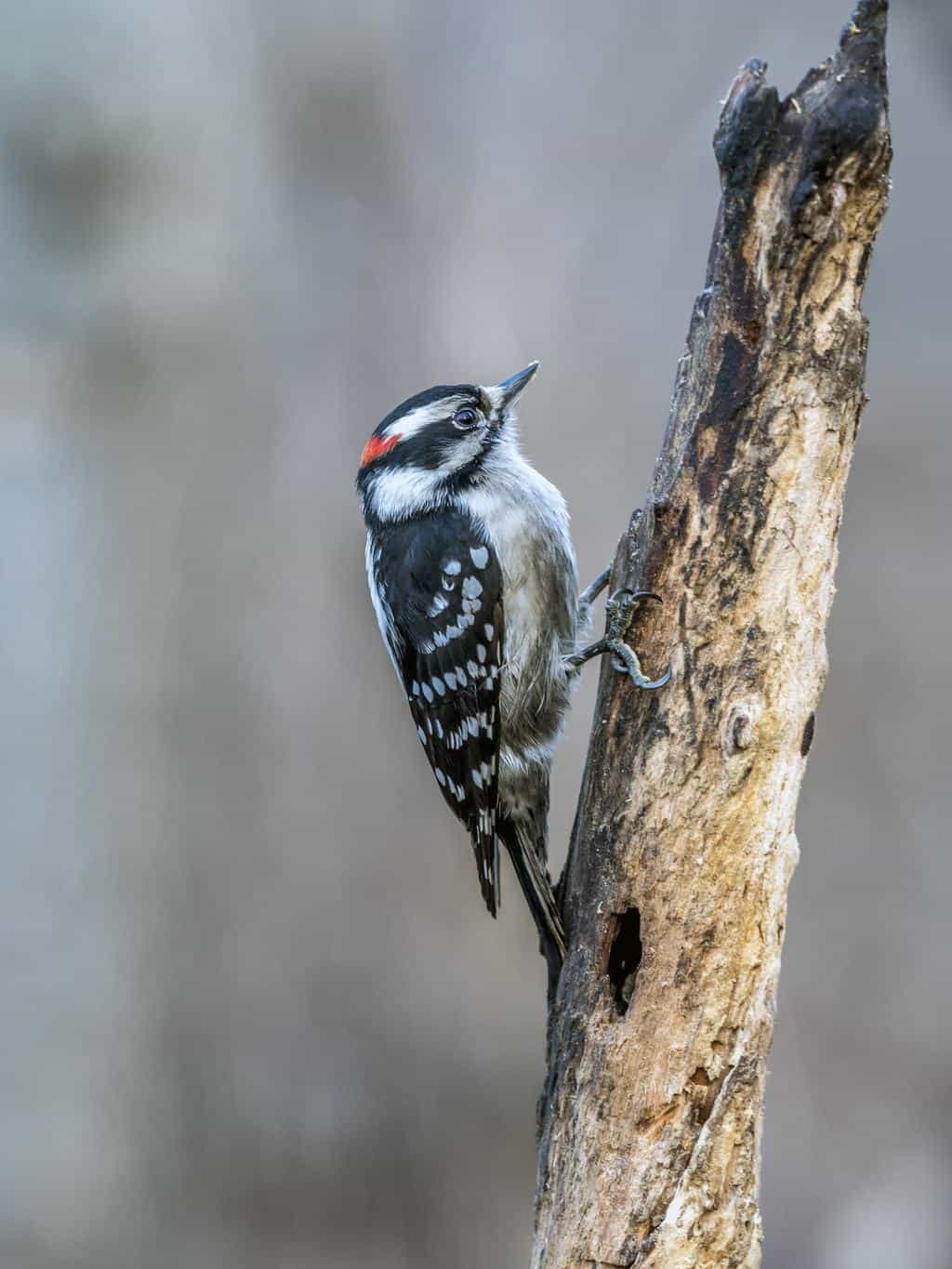
- Scientific Name: Dryobates pubescens
- Length: 5.5-7.1 inches
- Weight: 0.71-1.16 ounces
- Wingspan: 9.8-12.2 inches
To the untrained eye of a novice birdwatcher, downy and hairy woodpeckers are almost identical, but if you take a closer look, you’ll find that despite their similarities, these winged animals actually have a range of differences.
For identification purposes, note that downy woodpeckers are smaller — roughly two-thirds the size of hairy woodpeckers. Downies sport deep black bodies, white bellies, throats, and backs, and a striped head and neck. Much like their hairy cousins, males of this species grow a distinctive red patch at the back of the head.
Find these woodpeckers feeding on larvae, caterpillars, and crop pests, in addition to grains, seeds, wild berries, and acorns. If you have a feeder, it will probably make a stop in your backyard, and when it’s not scouring the open woodlands of Rhode Island for food, it likes to make lots of noise as it drums on trees and calls out other birds.
Hairy Woodpecker
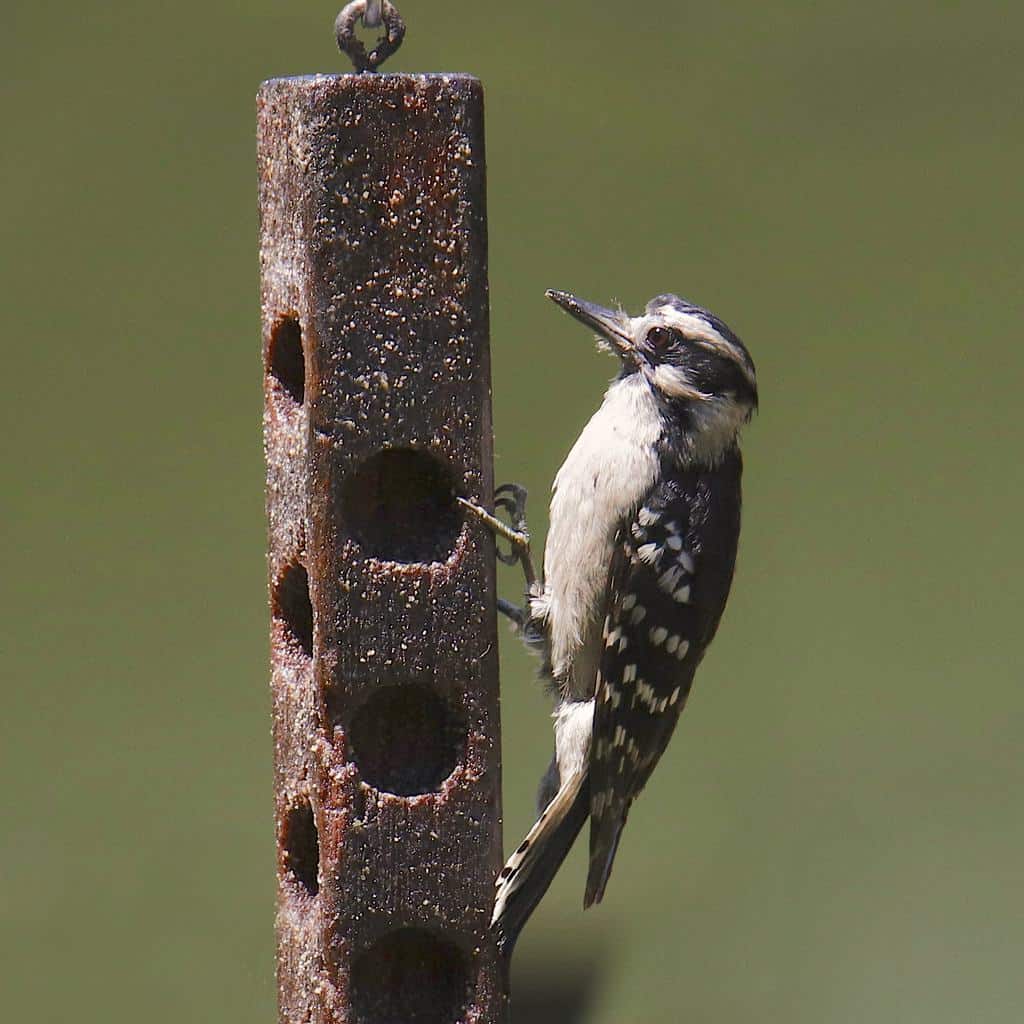
- Scientific Name: Leuconotopicus villosus
- Length: 7-10.2 inches
- Weight: 1.4-3.4 ounces
- Wingspan: 13.0-16.1 inches
As mentioned before, the easiest method of identification for a hairy woodpecker when downies are around is noting that woodpeckers in the hairy family are much bigger and have longer bills.
This woodpecker wears two white stripes on its head (with an extra flash of red on the males) and a checkered pattern on each wing.
Much like downy woodpeckers, the hairy woodpecker may visit a feeder or residential area, but it’s much more likely to spot them in mature forests, recently burned forests, and wood infested by beetles. It also gets attracted to the wells dug by sapsuckers, feeding on the sap and larvae, and usually nests in trees that were infected with heart rot.
The hairy woodpecker occasionally follows the pileated woodpecker around, feeding on larvae and insects our pileated pal may have overlooked.
Northern Flicker

- Scientific Name: Colaptes auratus
- Length: 11-14 inches
- Weight: 3-5.9 ounces
- Wingspan: 17-21 inches
The yellow-shafted northern flicker, also known as the common flicker, has yellow feathers on the underside of its tail and wings, making for easy identification. The rest of its body is brown with black markings and dots on its back and belly.
This woodpecker is a ground-feeder, spending its days walking along the earth searching for ants or foraging for moths, snails, nuts, grains, seeds, and larvae on horizontal logs and branches. If you’ve got a feeder in your backyard, fill it with suet, and one of these woodpeckers will more than likely make a stop at your home the next time it takes flight.
When it feels threatened, this woodpecker will drum on trees and the occasional metal object, hoping to make the loudest noises possible. And the lifespan of these woodpeckers is said to range from five to nine years, so backyard feeder owners in Rhode Island can expect to develop long-term relationships with these wonderful creatures.
Conclusion
Next time you’re in Rhode Island, it might be a good idea to keep an eye on the trees and your ears open. Woodpeckers aren’t difficult to spot and will announce their presence with their continuous drumming and loud calls.
Pro-tip: if there’s a dead tree on your property, leave it to attract woodpeckers, as long as it won’t cause any harm to your home. And in the winter, fill your feeder with suet; your feathered friends will thank you.











